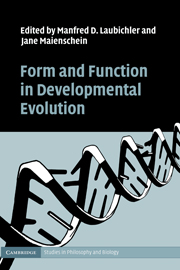Book contents
- Frontmatter
- Contents
- List of figures
- List of tables
- List of contributors
- List of journal abbreviations
- 1 Introduction
- 2 Form and function in Evo Devo: historical and conceptual reflections
- 3 Deducing plant function from organic form: challenges and pitfalls
- 4 Evolution in the light of embryos: seeking the origins of novelties in ontogeny
- 5 A focus on both form and function in examining selection versus constraint
- 6 Innovation and diversity in functional morphology
- 7 The developmental evolution of avian digit homology: an update
- 8 Functional analysis and character transformation
- 9 The nature of constraints
- 10 Toward a mechanistic Evo Devo
- Index
- References
10 - Toward a mechanistic Evo Devo
Published online by Cambridge University Press: 28 June 2009
- Frontmatter
- Contents
- List of figures
- List of tables
- List of contributors
- List of journal abbreviations
- 1 Introduction
- 2 Form and function in Evo Devo: historical and conceptual reflections
- 3 Deducing plant function from organic form: challenges and pitfalls
- 4 Evolution in the light of embryos: seeking the origins of novelties in ontogeny
- 5 A focus on both form and function in examining selection versus constraint
- 6 Innovation and diversity in functional morphology
- 7 The developmental evolution of avian digit homology: an update
- 8 Functional analysis and character transformation
- 9 The nature of constraints
- 10 Toward a mechanistic Evo Devo
- Index
- References
Summary
I have acquired the conviction that our biological theories must remain inadequate so long as we confine ourselves to the study of cells and persons and leave the psychologists, sociologists, and metaphysicians to deal with complex organisms.
W. M. Wheeler (1911)INTRODUCTION: TWO DISTINCTIONS
Manfred Laubichler's contribution to this volume contains a subtle argument to the conclusion that in evolutionary developmental biology (Evo Devo), form and function are both best understood as kinds of causes at different scales that can be brought together in mechanistic explanations of phenotypic evolution. This argument is evocative not only because it leans heavily on mechanistic explanation – about which much more below – but also because there have been long periods during which form was not understood to have a causal aspect. When the phenotype is a passive by-product of evolution, the form does not do much work.
Evo Devo, of course, is partly built around denying the correctness of one-sided explanatory strategies, and thus, if Laubichler is correct, finds itself brushing up against another familiar distinction. When Ernst Mayr (1961) made his cut between proximate and ultimate causation, he recognized two sorts of causes in biology, but minced no words about which he took to be the more important. It is possible, of course, to agree with Mayr's distinction and disagree with him about which kind of causes matter most, just as it is possible to reject the nature–nurture dichotomy and still wonder whether nature or nurture is more important.
- Type
- Chapter
- Information
- Form and Function in Developmental Evolution , pp. 213 - 224Publisher: Cambridge University PressPrint publication year: 2009
References
- 4
- Cited by



